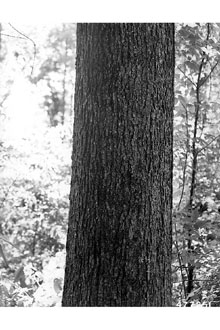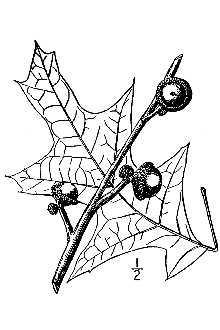Quercus pagodifolia (Elliott) Ashe
Scientific Name: Quercus pagodifolia (Elliott) Ashe

| General Information | |
|---|---|
| Usda Symbol | QUPA11 |
| Group | Dicot |
| Life Cycle | Perennial |
| Growth Habits | Tree |
| Native Locations | QUPA11 |
Plant Guide
Uses
Commercial use: The cherrybark tree has heavy strong wood that makes it an excellent timber tree for furniture and interior finish. This tree is also a pleasant shade tree and is a fast growing oak tree. Wildlife use: Many wild animals and birds use the acorns of the cherrybark as food. Within the range of this oak, animals and birds include acorns as a substantial part (10 percent or more) of their diets. Among these the heaviest eaters are the gray squirrel, wild turkey, and blue jay, followed by the wood duck, red-bellied woodpecker, redheaded woodpecker, white-breasted nuthatch, common grackle, raccoon, white-tailed deer, and eastern fox squirrel
Status
Please consult the PLANTS Web site and your State Department of Natural Resources for this plant’s current status (e.g. threatened or endangered species, state noxious status, and wetland indicator values).
Description
The cherrybark oak’s dark gray bark is broken by narrow ridges into small scales. Its twigs are rather stout, reddish brown to gray, usually hairy when young, becoming smooth as the tree matures. Its leaves are alternate, simple, pinnately divided into 5-11 pointed lobes, the sinuses cut no more than half-way to the mid-vein, smooth and shiny on the upper surface, paler and with star-shaped hairs on the lower surface, not U-shaped at the base, up to 10 inches long, up to 7 inches wide. Male and female flowers borne separately on the same plant, appearing when the leaves begin to unfold; male flowers crowded into slender, drooping spikes; female flowers few together. Flower: Cherrybark oak is monoecious; unisexual flowers of both sexes are borne on the same tree. Flowering occurs during April and May throughout most of the range. The staminate flowers are borne in naked aments (catkins) while pistillate flowers are green, solitary, very small, and borne on a short stalk. Fruit: Acorns are orange-brown nuts about 13 mm (0.5 in) long, globular or hemispheric. with up to one-third of their length enclosed in a shallow thin cap. This cap when young is scaly, and somewhat pubescent. It takes two years for the fruit to mature. Twig: The twigs are orange to reddish brown, often very pubescent with older twigs becoming glabrous; multiple terminal buds (1/8 to 1/4 inch) are pointed, reddish brown and have some pubescence on the upper half. Bark: The bark appears initially smooth, but quickly developing small scaly ridges, later becoming dark, scaly and quite rough. At times resembling black cherry bark. Distribution: Cherrybark oak is widely distributed on the best loamy sites on first bottom ridges and on well-drained terraces and colluvial sites. These sites occur along both large and small streams of the
Adaptation
Cherry bark oak is a tree for poor, dry, acidic uplands, especially upper slopes in the Appalachians. It is found mixed with other upland, poor site oaks, especially scarlet, black, white and post oaks, and with hickories and pines.
Establishment
.The fruit is solitary or paired; the nut is enclosed one-third or less in a thin, shallow cup. The fruit ripens in September and October, the second season after flowering, and seedfall occurs during these months. Seed production usually begins when a tree is about 25 years of age, but maximum production is usually between the ages of 50 and 75 years. Cleaned seeds average 1,190/kg (540/lb). Fall seeding of oaks is preferred to spring seeding in the nursery. To obtain the highest first-year survival, it is recommended the acorns be planted not less than 1/2 inch deep and at seedbed densities of 12 to 15 evenly spaced sound seed per square foot. Fall beds should be mulched with leaves or straw held in place by hardware cloth covers or other effective materials. The covering also serves as a protection against rodents. It is usually not necessary to produce seedlings older than 1-0 for field planting, but 2-0 seedlings are planted occasionally to obtain larger, vigorous stock with more extensive root systems. In natural stands, dissemination of acorns by gravity is important on steep slopes. The hoarding habit of squirrels is also important in the dispersal of seed of oaks. It germinates under natural conditions in the spring following seedfall. Cool, moist stratification is required for best results. Germination is hypogeal. Cherrybark oak sprouts vigorously from the stump when the top has been killed or cut back. Sprouting is most prevalent on young stems 25.4 cm (10 in) or less in diameter. With well-established root systems, growth of sprout-origin stands is rapid, regardless of site quality, for about 20 years. Equations have been developed using sprout height at age 5 which predict the diameter growth and competition success of coppice-regeneration at ages 12 and 30. Clones of southern red oak can be propagated from cuttings of rooted stump sprouts and mature branches. Cuttings from branches root better than cuttings from stump sprouts. Root initiation is increased when cuttings are treated with the growth hormone IBA and the fungicide folpet, and when cuttings 6.4 mm (0.25 in) or larger are taken from the first flush after it hardens off and just before second flush bud break. Survival after rooting is also increased when larger cuttings are used.
Pests and Potential Problems
Wood-boring insects often cause much damage in fire-scarred cherrybark oaks and in over mature trees, Moreover, on poorly drained clay flats or other poor sites, the mature trees are often infested with borers or the wood is mineral streaked, Fires and hurricane winds seem to be instrumental in introducing the borers and mineral streaks, Trunk boring insects found in cherrybark oak are the carpenterworm (Prionoxystus robiniae), red oak borer (Enaphalodes rufulus), oak clearwing borer (Paranthrene simulans), and the living-beech borer (Goes pulverulentus) (34,35), Oak twig galls (multiple species) are a common occurrence in the loessial hills and coastal plain sites, Insects identified as attacking southern red oak probably also attack cherrybark oak; these are the defoliating Anisota oak worms (Anisota spp,), the two lined chestnut borer (Agrilus bilineatus), Columbian timber beetle (Corthylus columbianus), and pecan carpenterworm (Cossula magnifica), Other probable cherrybark oak insects are the hickory spiral borer (Agrilus arcuatus var, Use soil moisture sensors to measure the soil moisture of Quercus pagodifolia (Elliott) Ashe., torquatus) and the oak-stem borer (Aneflormorpha subpubescens), Hispidus canker (Polyporus hispidus) is common on cherrybark oak, Rot fungi attacking southern red oak and possibly cherrybark oak are Hericium erinaceus, Laetiporus sulphureus, and Daedalea quercina, Leaf blister caused by Taphrina caerulescens occurs frequently, Cherrybark oak is susceptible to oak wilt (Ceratocystis fagacearum), Heart rot in standing cherrybark oak trees generally is greater on poor sites than on good sites, As in most of the oaks, the acorn is subject to damage by nut or acorn weevils, such as Curculio baculi, C, longidens, C, pardalis, and Conotrachelus posticatus, and the filbertworm (Melissopus latiferreanus, Pine voles have destroyed cherrybark oak seedlings in out plantings in the loess hills, Cultivars, Improved, and Selected Materials (and area of origin) These materials are readily available from commercial plant sources, Contact your local Natural Resources Conservation Service (formerly Soil Conservation Service) office for more information, Look in the phone book under “United States Government,” The Natural Resources Conservation Service will be listed under the subheading “Department of Agriculture,”
Plant Traits
Growth Requirements
| Temperature, Minimum (°F) | -7 |
|---|---|
| Adapted to Coarse Textured Soils | No |
| Adapted to Fine Textured Soils | Yes |
| Adapted to Medium Textured Soils | Yes |
| Anaerobic Tolerance | None |
| CaCO3 Tolerance | None |
| Cold Stratification Required | Yes |
| Drought Tolerance | Low |
| Fertility Requirement | High |
| Fire Tolerance | Low |
| Frost Free Days, Minimum | 210 |
| Hedge Tolerance | None |
| Moisture Use | Medium |
| pH, Maximum | 6.0 |
| pH, Minimum | 4.5 |
| Planting Density per Acre, Maxim | 800 |
| Planting Density per Acre, Minim | 300 |
| Precipitation, Maximum | 70 |
| Precipitation, Minimum | 40 |
| Root Depth, Minimum (inches) | 36 |
| Salinity Tolerance | None |
| Shade Tolerance | Intolerant |
Morphology/Physiology
| Bloat | None |
|---|---|
| Toxicity | None |
| Resprout Ability | Yes |
| Shape and Orientation | Erect |
| Active Growth Period | Spring and Summer |
| C:N Ratio | High |
| Coppice Potential | No |
| Fall Conspicuous | Yes |
| Fire Resistant | No |
| Flower Color | Yellow |
| Flower Conspicuous | No |
| Foliage Color | Green |
| Foliage Porosity Summer | Dense |
| Foliage Porosity Winter | Porous |
| Foliage Texture | Medium |
| Fruit/Seed Conspicuous | Yes |
| Nitrogen Fixation | None |
| Low Growing Grass | No |
| Lifespan | Moderate |
| Leaf Retention | No |
| Known Allelopath | No |
| Height, Mature (feet) | 120.0 |
| Height at 20 Years, Maximum (fee | 60 |
| Growth Rate | Moderate |
| Growth Form | Single Stem |
| Fruit/Seed Color | Brown |
Reproduction
| Vegetative Spread Rate | None |
|---|---|
| Small Grain | No |
| Seedling Vigor | Medium |
| Seed Spread Rate | Slow |
| Fruit/Seed Period End | Fall |
| Seed per Pound | 580 |
| Propagated by Tubers | No |
| Propagated by Sprigs | No |
| Propagated by Sod | No |
| Propagated by Seed | Yes |
| Propagated by Corm | No |
| Propagated by Container | Yes |
| Propagated by Bulb | No |
| Propagated by Bare Root | Yes |
| Fruit/Seed Persistence | No |
| Fruit/Seed Period Begin | Summer |
| Fruit/Seed Abundance | High |
| Commercial Availability | Routinely Available |
| Bloom Period | Mid Spring |
| Propagated by Cuttings | No |
Suitability/Use
| Veneer Product | Yes |
|---|---|
| Pulpwood Product | Yes |
| Post Product | No |
| Palatable Human | No |
| Palatable Browse Animal | Medium |
| Nursery Stock Product | Yes |
| Naval Store Product | Yes |
| Lumber Product | Yes |
| Fuelwood Product | High |
| Fodder Product | No |
| Christmas Tree Product | No |
| Berry/Nut/Seed Product | No |

